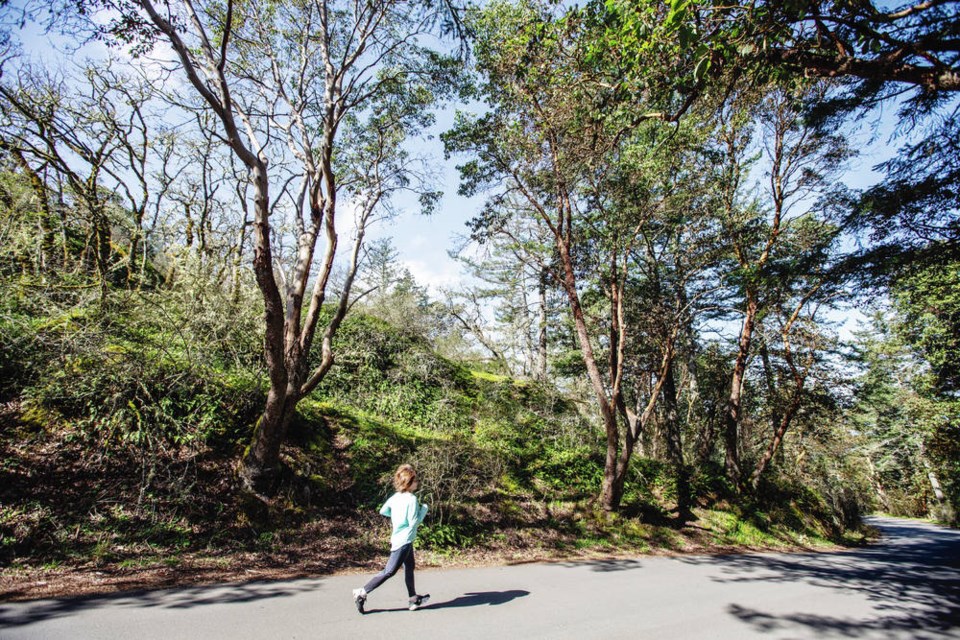He gasped: “19:43. You?”
I checked my phone. “18:01. It felt slow, too.”
Nature Boy and I have taken to climbing Churchill Drive to the top of Mount Douglas for exercise. I have done this jaunt often over the years.
And early on in those years, I had established a rough benchmark for how long it should take me to march up the steep 1.5-kilometre road.
My time-keeping device back then was a wristwatch — the old-fashioned kind, with minute and second hands, that tended to lose about a minute a week or so. It wasn’t automatically synched, with 99 per cent of other clocks, to the Great Apple or Google or Samsung Clock that now runs our lives and, seemingly, the world. That clock didn’t exist then.
The benchmark, therefore, was approximate. According to the minute hand on my lagging watch, I took 17-18 minutes to charge, march, trudge, drag myself from the lower parking lot to the summit parking lot.
It’s easy to forget that the precision of timekeeping and other measures we take for granted is only about a generation old. Technology has changed how we approach time, distance and so much more.
Now, when somebody dictates a time or place, that unarguably is the time or the place. It’s not that time give or take five or 10 minutes. It’s not that place thereabouts — “I’ll look for you.”
We may graciously make allowances for the difficulty of finding parking, but if somebody is a few minutes late for coffee or a meeting, it is duly noted in the Book of Accounts by those who had arrived before or on the appointed Tech time dot.
I recall meeting a retired navy commander for an interview in 2004 — three years before the iPhone, when the Blackberry was still It. I had arranged to meet him at his home at 10 a.m. I checked my slightly lagging wristwatch — the same watch that provided me with my Mount Doug benchmark — as I walked up the steps to his door: 9:58. But when he opened the door as I was about to knock, he told me I was two minutes and 21 seconds late.
I’m pretty sure he was joking.
“Perhaps we should have synchronized timepieces,” I laughed.
These days, we’re all synchronized, and we all expect military-like promptitude and precision.
That same long-retired commander would have encountered a similarly different accounting when he was working the ships he’d spent his career on. Until satellite technology took over, the best charts of many regions of the world’s oceans were old.
Friends who had sailed from Vancouver to Australia via the South Pacific carried on their voyage charts that were copies of those plotted by James Cook and his crew in the late 1700s. Through the centuries since Cook, people sailing those waters understood the charts were detailed, reasonably reliable and … well, approximate. If an atoll, for example, was marked at such-and-such a latitude and longitude, wise navigators would begin keeping watch some distance away … because you just never knew.
Until GPS and satellite imagery permitted updated charts and made real-time geographic positioning possible, presuming precise co-ordinates on the high seas was risky. (It might still be risky.)
I now march up Mount Doug to Tech time, not to idiosyncratic, close-enough old-fashioned Timex time. But that (approximate) benchmark established years ago still stands.
And the comparison between Tech time and wristwatch time, combined with the effects of the intervening years, doesn’t feel good. I now know exactly how many minutes, seconds or hundredths of a second longer (or shorter) I take to hike the hill every day. If the stopwatch on my phone says anything starting with “17:…” or less, it’s a good day. If it says “18:…,” even if it’s “18:01:…,” I feel I’m not measuring up.
And telling myself that Timex time and smartphone time are two entirely different approaches to viewing the world doesn’t matter.
The difference between the approximately 17-18 Timex minutes of 15 years ago and the 18:01 smartphone minutes of last week irks.



